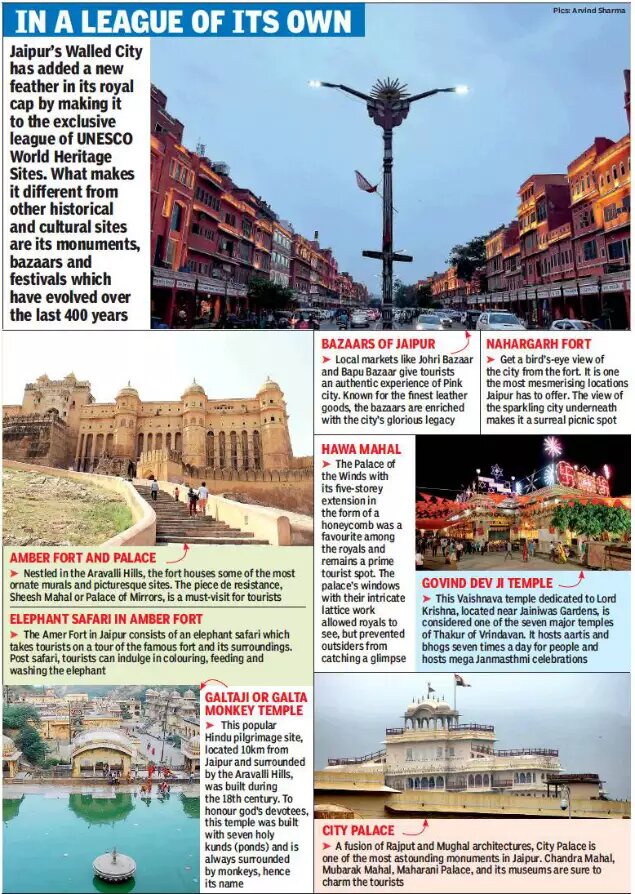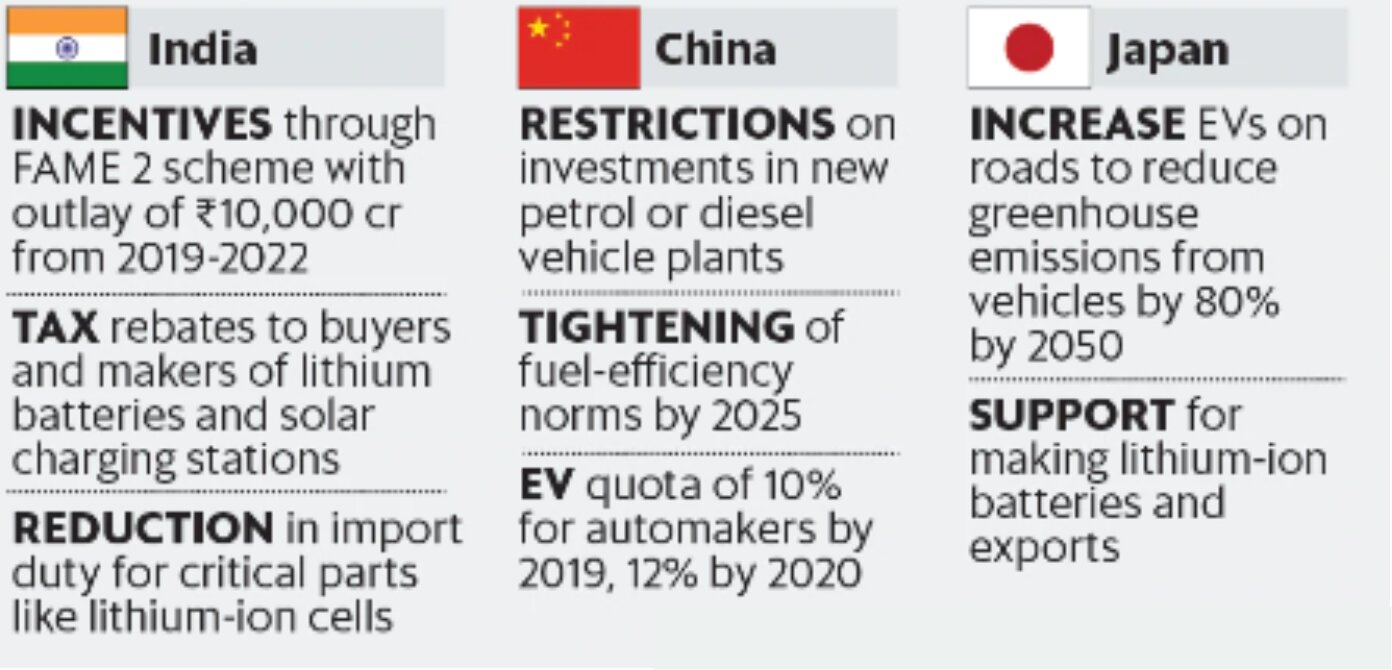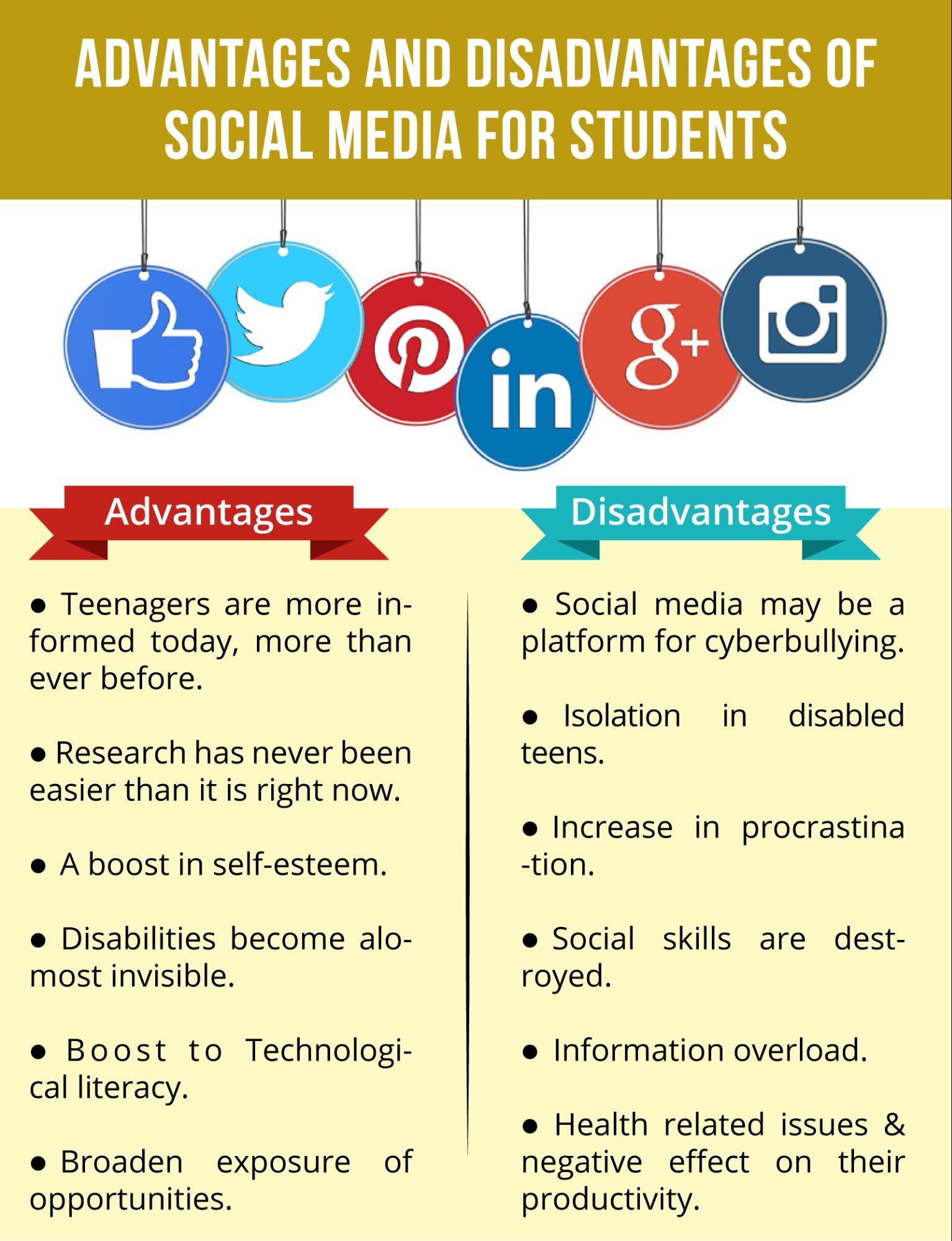Indian Heritage & Culture
Jaipur: A World Heritage Site
The Pink city, Jaipur (Rajasthan), has been declared a UNESCO World Heritage Site.
- The decision was taken at the 43rd session of the UNESCO World Heritage Committee (WHC) taking place in the city of Baku, Azerbaijan, from 30th June - 10th July, 2019.
- The city was nominated for its value of being an exemplary development in town planning and architecture that demonstrates an amalgamation and important exchange of ideas in the late medieval period.
Important Points
- Jaipur has become the second city of the country after Ahmedabad to get the recognition.
- With Jaipur's inclusion as a cultural site, the number of heritage sites across India that are on the UNESCO World Heritage list, has grown to 38, including 30 cultural properties, 7 natural properties and 1 mixed site.
- The walled city of Jaipur in Rajasthan, was founded in 1727 AD under the patronage of Sawai Jai Singh II. It also serves as the capital city of the state of Rajasthan.
- Unlike other cities in the region located in hilly terrain, Jaipur was established on the plain and built according to a grid plan interpreted in the light of Vedic architecture.
- Its streets feature rows that intersect in the centre and create large public squares called chaupars.
- The city's urban planning shows an exchange of ideas from ancient Hindu and modern Mughal as well as Western cultures.
- Designed to be a commercial capital, the city has maintained its local commercial, artisanal and cooperative traditions to this day.
- The iconic monuments in the city include the Govind Dev temple, City Palace, Jantar Mantar, Hawa Mahal etc.
UNESCO World Heritage Committee (WHC)
- The World Heritage Committee is composed of representatives of 21 States Parties to the World Heritage Convention who meet annually.
- The Convention Concerning the Protection of the World Cultural and Natural Heritage is an international agreement that was adopted by the General Conference of UNESCO in 1972.
- It is based on the premise that certain places on Earth are of outstanding universal value and should therefore form part of the common heritage of humankind.
- It basically defines the kind of natural or cultural sites which can be considered for inscription on the World Heritage List.
- The Committee is in charge of implementing the Convention.
- To date, 1,092 sites in 167 countries have been inscribed on the World Heritage List.
Agriculture
Income Inequality Among Farmers
- A recent survey conducted by NABARD, highlights the high levels of inter-state income inequality among the agricultural household in India.
- The data given in the survey depicts that inter-state income inequality among agricultural household range from Rs 16,020 (In Punjab: highest) to Rs 5,842 (In Andhra Pradesh: lowest).
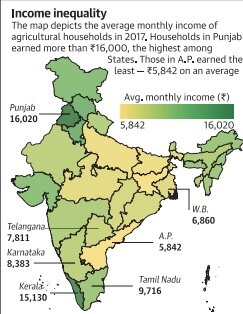
- Adding more to the grim picture of agricultural distress, the surplus remains after consumption expenditure is just Rs 95 in Andhra Pradesh and Rs 4,314 In Punjab.
- The data given in the survey depicts that inter-state income inequality among agricultural household range from Rs 16,020 (In Punjab: highest) to Rs 5,842 (In Andhra Pradesh: lowest).
- Also, according to the survey, 85% of farmer households earn a mere 9% of the total income, while the top 15% earn 91%.
- If it is compared with the overall inequality in India, it’s far too high.
- Given the stark inequality in India, it shouldn't come as a surprise when the report says that 43 per cent of India’s indebted households is farm households.
- This aspect is important in the context of the government’s target of doubling farmers’ income.
- Land possession was the key variable in determining income from cultivation, which accounted for half of the income inequality and hence was the key variable in explaining income inequality.
- The lowest among the farmer groups in terms of landholding earns the least.
- India primarily consists of small and marginal farmers(Farmers whose land holdings are less than two hectares (Ha) of land. About 85% landholdings in India are below two Ha)
- So this makes small farmers take longer to increase their income in comparison to large farmers.
- According to Ashok Dalwai committee doubling farmers’ income by 2022: The initial promise of agrarian reforms was to distribute land to the landless and provide the title of ownership to the cultivators.
- Unfortunately, India’s agrarian reforms did not ensure egalitarianism in the agricultural community.
- The Green Revolution in the 1960s focused on increasing productivity and yield. But since then, landholdings have become significantly fragmented. Marginal landholdings have tripled in the last 40 years.
Indian Economy
Budget Widens RBI’s Autonomy
The Union budget 2019-20 has expanded the Reserve Bank of India’s powers by bringing Housing Finance Companies (HFCs) under its ambit and deepening its governance over Non-Banking Finance Companies (NBFCs).
- Increase in RBI’s autonomy can be attributed to the crisis at Infrastructure Leasing and Financial Services Ltd (IL&FS), which led to a liquidity crisis in NBFC sector.
- With reference to IL&FS crisis , Serious Fraud Investigation Office (SFIO) had also noted that timely RBI intervention could have averted the crisis.
Wider Regulatory Powers: The Union budget 2019-20 has proposed to amend the RBI Act 1934, in order to strengthen the central bank’s autonomy and regulatory powers in following domains:
- It can supersede the board of NBFCs (other than those owned by the government) in the public interest or to prevent the affairs of NBFC being conducted in a manner detrimental to the interests of the depositor or creditor.
- It can remove and can further appoint the director of a board of NBFC.
- The proposed amendment to the RBI act will allow it to frame schemes for amalgamating, splitting and reconstructing an NBFC that will enable resolution of financially troubled NBFCs through a merger or by splitting them into viable and non-viable units called bridge institutions.
- RBI can also remove auditors, call for audit of any group company of an NBFC, and have control over the compensation of senior management.
Biodiversity & Environment
Immunocontraceptives for Wildlife Population Management
The Ministry of Environment, Forest and Climate Change (MoEFCC) has launched a project for undertaking ‘immunocontraceptive measures’ for population management of wild animals.
- The project includes four species of wild animals, viz. Elephant, Wild boar, Monkeys and Blue Bull (Nilgai).
- Pilot project will begin in Uttarakhand and then implemented in rest of the country.
- The Wildlife Institute of India (WII) and the National Institute of Immunology (NII) will develop a protocol of immunocontraception.
Immunocontraception
- Immunocontraception is a birth control method that uses the body's immune response to prevent pregnancy. It is a technology that uses a female animal’s immune system to build a protein around the egg that prevents it from fertilising.
- It is a humane, nonlethal solution to conflicts between people and wildlife as well as a solution to local problems of animal overabundance.
- Immunocontraception can also help reduce the overproduction of captive animals in zoos and other facilities.
- It is also a novel approach to the development of family planning methods.
- Despite the availability of contraceptive methods, there are over one million elective abortions globally each year due to unintended pregnancies, having devastating impact on reproductive health of women worldwide.
- This highlights the need for the development of newer and improved contraceptive methods.
Need
- Human-animal conflict has emerged as a major challenge in managing wildlife in the country.
- Human-elephant conflict causes the maximum number of casualties every year. According to reply tabled in Parliament on June 28, 2019, nearly 494 persons were killed by elephants in 2018.
- Between 2014 and March 2019, 2,398 people died in elephant attack in the country, with West Bengal accounting for maximum number of such deaths.
Challenges
- It requires mathematical modelling and knowing the adult female population in the group that has to be delivered the vaccine.
- The implementation of such a project in India will not be a simple task. It will involve multidisciplinary effort over a long period of time to deliver the contraceptive and manage the logistics around it
- India has relatively large Elephant population, where identifying individuals is difficult.
- Use of hormonal contraceptives in wildlife are easily passed from animal to animal. This can lead to unintended ecological consequences.
- For instance, fish exposed to treated sewage effluents were found to have concentrations of the synthetic hormone in blood plasma higher than those found in humans taking hormonal contraceptives.
- However, the antigens used in contraceptive vaccines are protein, not steroids, they are not easily passed from animal to animal without loss of function. Yet, more research needs to be undertaken.
Governance
Union Budget and E-Vehicles
The Union Budget 2019-20 included several incentives for developing electric vehicle industry (EV Industry) in India.
- Income tax rebates of up to ₹1.5 lakh to customers on interest paid on loans to buy electric vehicles, with a total exemption benefit of ₹2.5 lakh over the entire loan period.
- Customs duty exemption on lithium–ion cells, which will help lower the cost of lithium-ion batteries in India as they are not produced locally.
- This is in addition to the ₹ 10,000 crore allocated for EVs under the FAME II scheme.
- Makers of components such as solar electric charging infrastructure and lithium storage batteries and other components will be offered investment linked income tax exemptions.
- Proposal to reduce GST rate on electric vehicles from the current 12% to 5%.
The State of EVs in India
- According to the Economic Survey, the market share of electric cars is only 0.06 % in India when compared to 2 % in China (world’s largest EV market) and 39 % in Norway.
- Reasons for lesser market presence of EVs in India are lack of charging infrastructure and high cost.
Steps Taken by Other Countries
- In major cities in developed markets such as Frankfurt (Germany) and others, EVs are given free parking space and in certain parts of cities only such eco-friendly vehicles are allowed.
- European Union (EU) countries are also trying to evolve into a hub for developing batteries and other spare parts for electric vehicles through the Strategic Action Plan For Batteries.
- The continent hosts the countries with the largest base of electric car sales. Norway, for instance, leads the electric vehicle market—EVs comprised 46% of the total vehicles sold in the country in the year 2018.
- In the US, California is legislating tough emission norms for vehicles and providing fiscal incentives for plug-in hybrid and battery electric vehicles.
Way Forward
- The government can think of giving a mandate to leading manufacturers that they should have a certain share of their sales from EVs after a particular time period.
- The NITI-Aayog is considering a policy proposal to ban all internal combustion engine two-wheelers under 150cc by the year 2025 and three-wheelers by the year 2023.
- Access to fast-charging facilities must be fostered to increase the market share of electric vehicles. Investments from private players is required for the same.
Indian Society
Effect of Social Media on Teens
As per a recent survey conducted by Fortis hospital, around 82% of students studying psychology in classes XI and XII in at least 200 schools across major cities in India, have said that social media has influenced their opinions and attitudes.
- Even the general reaction of the public at large is that social media is addictive for young people and that they should avoid it.
- But such knee-jerk reaction is not right as use of any media can have both positive and negative influences. It all depends on how children interact with the medium.
- For example close 78% of a total of 4,000 students who were polled for a survey said they spend a lot of time a day on social media and that it should be used as a tool to spread awareness and dispel myths about mental health issues.
- On mental health issues, 46% said mainstream media is not doing enough to create awareness and 32% believed that it has, in fact, increased stigma.
- The Fortis survey found that 94% of the students believed that social media is a means to create awareness.
- Children need to be taught that media is not a one-sided communication; they must be taught about the authenticity of the news or the news is just appealing to their emotions.
- For the purpose, parents need to create media literacy so that children can use the medium to their benefit.
Internal Security
Vacancies in Policing
The Bureau of Police Research and development’s report on “vacancies in the police organization” has revealed that in India, 5.28 lakh police posts are lying vacant.
- High vacancy rate in police organizations points toward the deficiencies in Indian policing that needs to be tackled through police reforms.
Key Findings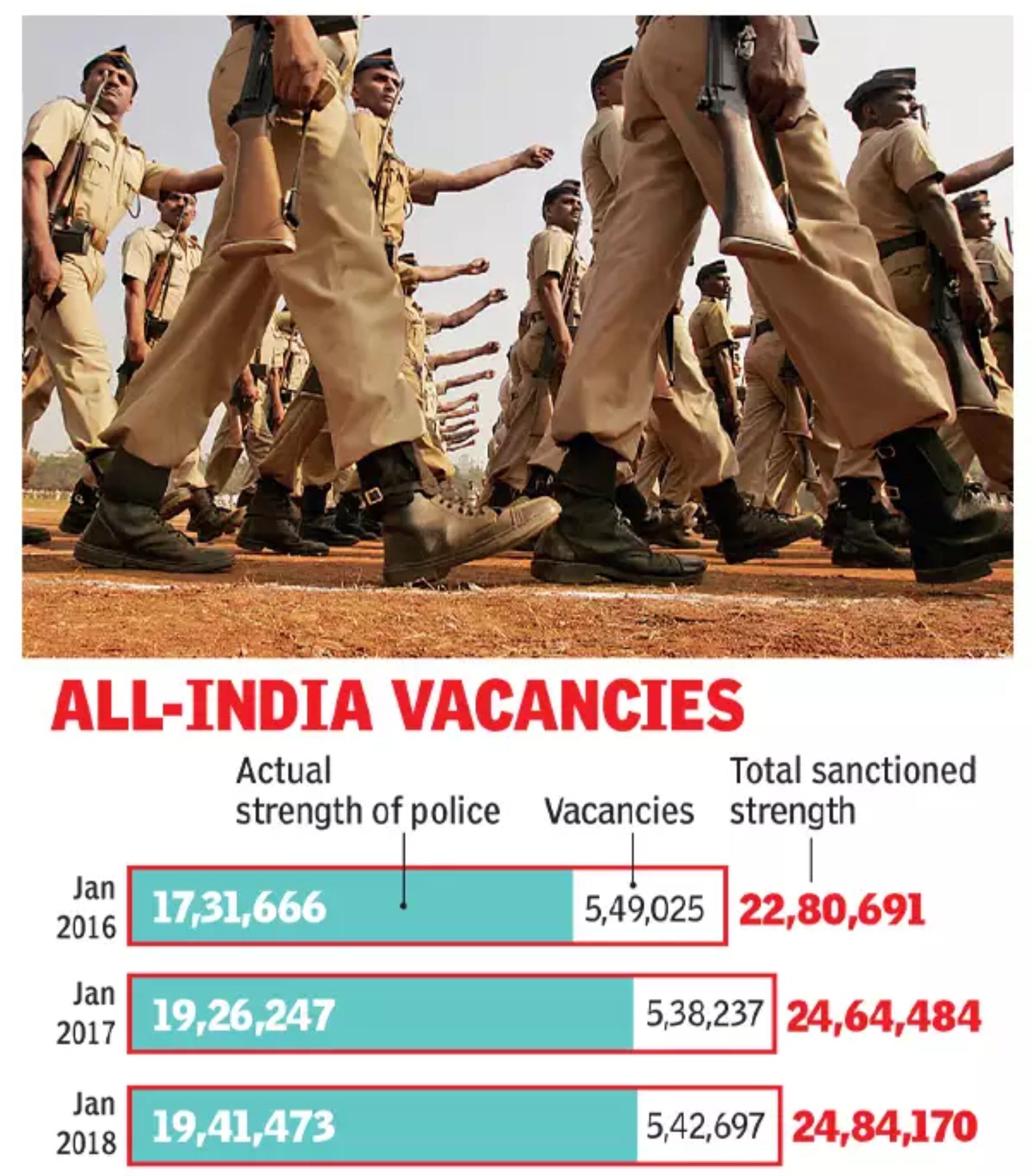
- There are 23,79,728 sanctioned posts in police forces of all states of which only 18,51,332 were occupied.
- The states with high shortage of police personnel included Uttar Pradesh, Bihar, West Bengal, Telangana, and Maharashtra while Nagaland is the only state where actual strength exceeded the sanctioned strength.
- The wide difference between sanctioned and actual strength of vacancies can be attributed to reasons like slow recruitment process, retirement, and untimely deaths.
- Naxal-affected Chhattisgah has 11,916 posts vacant in its sanctioned 71,606 posts, while the Odisha Police has 10,322 vacant posts against its sanctioned strength of 66,973 posts.
- Insurgency-hit Assam has 11,452 vacant posts in its sanctioned strength of 65,987 personnel while Jammu and Kashmir has 10,044 posts vacant in its sanctioned strength of 87,882 posts.
Bureau of Police Research and Development
- Bureau of Police Research and Development (BPR&D), under the Ministry of Home Affairs has the primary objective of modernization of police force.
- It takes direct and active interest in policing issues and promotes a speedy and systematic study of the police problems.
- In addition to two existing divisions (namely, Research, Statistics and Publication and Development) a training division was also set up under BPR&D on the recommendations of Gore committee in 1973.
- Issues relating to Correctional Administration Work are under BPR&D so that problems relating to prisons and implementation of deemed prison reforms can be taken up by the Bureau in a cohesive manner.
- The National Police Mission is also under the administrative control of BPR&D to transform the police forces in the country into effective instrument for maintenance of internal security and facing the challenges in the future, by equipping them with the necessary material, intellectual and organizational resources.
Important Facts For Prelims
Road Accidents in India
According to data tabled by the Ministry of Road Transport & Highways in the Parliament, road accidents in India killed between 1.46 lakh and 1.5 lakh people every year between 2015 and 2017, which works out to a daily average of 400 or more deaths in each of the three years.
- The analysis was done for all roads, including national highways and expressways.
- Uttar Pradesh has the highest number of deaths in road accidents in each of the three years, followed by Tamil Nadu.
- Together, these two states accounted for nearly one-fourth of all such deaths in the country in 2016 and 2017.
- It can also be noted that according to the Global Status Report on Road Safety 2018, released by the World Health Organization (WHO), road accidents are the eighth leading cause of death for all age groups surpassing HIV/AIDS, tuberculosis and diarrhoeal diseases.
Important Facts For Prelims
Elephant Rehabilitation Centre
India’s first elephant rehabilitation centre is to be set up in Kottoor, Kerala.
- It is being planned on the lines of the Pinnawala Elephant Orphanage in Sri Lanka.
- Rehabilitation centre is aimed at providing protection to abandoned, orphaned, injured and older elephants.
- It is planning to give an opportunity for people to know more about elephants and will be a boon for wildlife researchers and veterinary students.
- The rehabilitation centre is expected to have an elephant museum, mahout training center, super-specialty hospital, a retirement home and crematorium for the animals.
- Recently India has also opened its first water clinic for elephants suffering from arthritis, joint pain and foot ailments at a wildlife SOS Elephant Hospital, Mathura, UP.
Important Facts For Prelims
India’s First Cow Sanctuary
India’s first cow sanctuary, Kamdhenu Gau Abhayaranya, will be privatised soon.
- Located in Agar-Malwa district (Madhya Pradesh), the sanctuary was established in the year 2017 at a cost of Rs 32 crore and can house around 6,000 cows at full capacity.
- It mainly has cows which are old and sick or have stopped producing milk.
- Over the last one year, more than 600 cows died due to extreme weather conditions. The government is finding it hard to tackle with the same.
- The decision of privatisation has also been taken due to the financial crisis.
- The government is looking for a social or religious organisation to manage the sanctuary and serve the cows.

